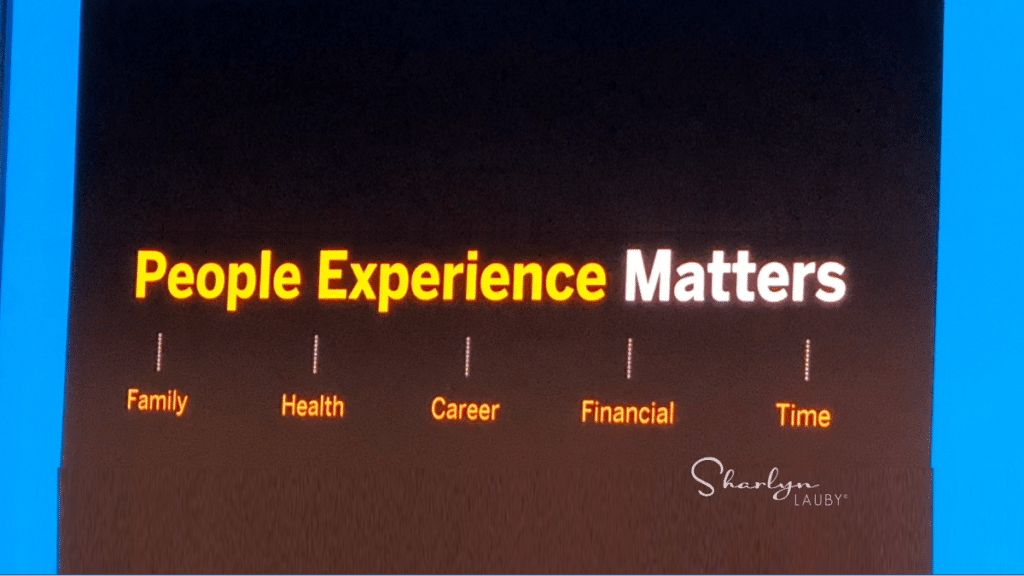Human Experience Management #HXM – 4 Essential Culture Components

Last year, I shared a series of LinkedIn Live shows about “The Rise of HXM – Human Experience Management”. HXM was introduced at SAP SuccessFactor’s conference and is defined as being more than the employee experience. HXM is exactly what it sounds like – it’s about treating individuals as humans versus employees. But what does that mean? What are the key components to having a human experience?
I was cleaning up a few files around my office and came across my notes from the event. I had identified four key elements of delivering HXM:
Wellbeing: To confirm we’re all on the same page, wellbeing is defined as “the state of being comfortable, healthy, or happy”. I don’t believe this means 100% of the time. Realistically speaking, there will be days when we’re not any of those things. I think wellbeing is about being comfortable, healthy, or happy the majority of the time. And when we’re not, wellbeing is about feeling safe to say that. Employees should be able to let their managers know when they’re unhappy with a decision or need a lighter workload. In turn, management will support the employee and not immediately view it as slacking or shirking responsibilities.
Civility: Organizations need to have cultures where civility exists, and people are held accountable for uncivil behavior. Even if you’re the organization’s top sales producer. There’s no excuse for impoliteness and bad manners. Let me also clarify that being civil doesn’t mean that you’re not able to deliver tough conversations or share bad news. Unfortunately, we have to do that occasionally. Civility is about being able to deliver unpleasant messages with empathy, respect, and professionalism.
Learning: Over the years, we’ve all probably seen at least one article about the importance of being a lifelong learner. It’s true and we should continue to learn. Human experience management is about creating a learning culture component, where employees feel they can continuously learn and grow – whether that’s in a formal classroom learning environment or virtual self-directed development. Learning helps us grow which can benefit our wellbeing. The activity necessary for a successful learning culture is management support.
Recognition: Organizations should pay employees fairly and offer competitive benefits. That should go without saying. In addition, organizations need to demonstrate sincere recognition for work well done and goal achievement. At every level of the company. Sincere recognition should be timely and delivered in a way that’s meaningful to the individual receiving it. Recognition contributes to wellbeing. When it’s done properly, it displays appreciation and civility.
Some people might be saying, “I get it. Our organization has these things.” That’s great. What I believe takes this conversation from wellbeing programs, civility training, learning departments, and recognition programs TO human experience management (HXM) is how they are aligned. HXM isn’t about four separate programs. It’s about building all of these things into everything the organization does.
- In recruitment, do hiring managers start building a positive working rapport with candidates so when they get hired, they already feel safe to bring up wellbeing?
- In training programs, are employees given the opportunity to practice delivering tough messages so they can do it effectively and respectfully?
- Does the organization regularly conduct debriefs so employees have the opportunity to talk about what they’ve learned and how they can apply it in the future?
- Do managers ask employees during one-on-one meetings how they like to be recognized for their work?
These are just a few of the many questions that organizations might want to ask to make sure that HXM components aren’t simply programs or checklists but rather actions that demonstrate every day the human work experience.
Now more than ever, employees are looking for a real authentic human work experience. They want to know that the organization views them that way. This isn’t to say that employees aren’t prepared to do hard work – trust me, they are. But they expect to be treated as a human first.
Image captured by Sharlyn Lauby at the 2019 SAP SuccessFactors Conference in London, England
15